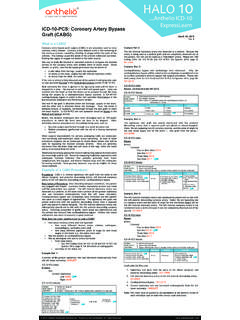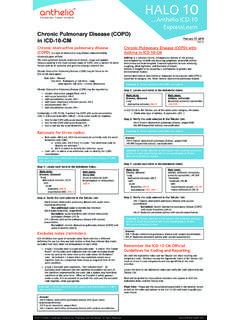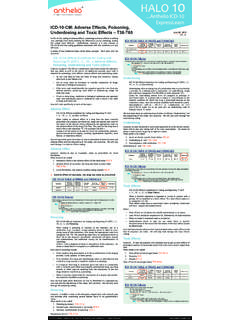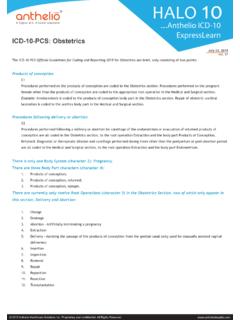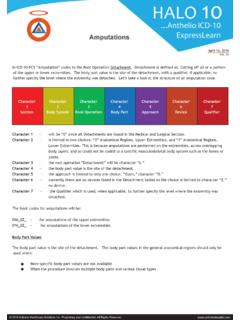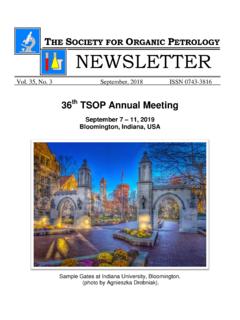Transcription of ICD-10-CM: Myocardial Infarction (MI) - Anthelio
1 HALO 10.. Anthelio ICD-10. ExpressLearn ICD-10-CM: Myocardial Infarction (MI). April 3, 2015. Vol. 9. What is a Myocardial Infarction (MI)? A Myocardial Infarction (MI), commonly known as a heart attack, occurs when 4) Subsequent acute Myocardial Infarction a portion of the heart is deprived of oxygen due to blockage of a coronary A code from category I22, Subsequent ST elevation (STEMI) and artery. Coronary arteries supply the heart muscle (myocardium) with non ST elevation (NSTEMI) Myocardial Infarction , is to be used oxygenated blood. Without oxygen, muscle cells served by the blocked when a patient who has suffered an AMI has a new AMI within artery begin to die (infarct).
2 Injury to the heart muscle causes chest pain the 4 week time frame of the initial AMI. A code from category and chest pressure sensation. If blood flow is not restored to the heart I22 must be used in conjunction with a code from category I21. muscle within 20 to 40 minutes, irreversible death of the heart muscle will The sequencing of the I22 and I21 codes depends on the begin to occur. Muscle continues to die for six to eight hours at which time circumstances of the encounter. the heart attack usually is "complete." The dead heart muscle is eventually What does the coder need to know to code a Myocardial replaced by scar tissue. Infarction ? What may cause a Myocardial Infarction (MI)?
3 Is there documentation of STEMI or NSTEMI. Occlusive intracoronary thrombus - a substance called plaque can build up in Is a site given the walls of your coronary arteries. This plaque is made up of cholesterol and If a site is given, but no information as to STEMI or NSTEMI, other cells. A heart attack may occur when a tear in the plaque occurs which code to STEMI by site triggers blood platelets and other substances to form a blood a clot at the Please see AHA Coding Clinic for ICD-10-CM and site that blocks blood from flowing to the heart. This is the most common ICD-10-PCS 1st Quarter 2013 pages 25-26. cause of heart attack. Another cause may be when a slow buildup of plaque Is the patient admitted with an initial MI or a subsequent MI.
4 May narrow one of the coronary arteries so that it is almost blocked. What is the time frame of onset of the MI and/or subsequent MI. Vasospasm - with or without coronary atherosclerosis; possibly associated with platelet aggregation. Note: Prinzmetal or variant angina is believed to Example 1: be due to vasospasm in coronary arteries without obstructive lesions. Patient presents with a chief complaint of chest pain admitted to Coronary Emboli - from left sided mural thrombosis, vegetative endocarditis, or Care Unit due to acute inferior Myocardial Infarction . paradoxic emboli (this is rare) from the right side of heart through a patent foramen ovale.
5 HISTORY OF PRESENT ILLNESS: The patient is a 40-year-old white male who presents with a chief complaint of "chest pain". Finally, the cause of heart attack is not always known. REVIEW OF SYSTEMS: All other systems reviewed & are negative. Types of Myocardial Infarctions TREATMENT: ST Elevation Myocardial Infarction (STEMI) or Transmural Acute MI, Heparin lock X. 2. is associated with atherosclerosis involving a major coronary artery. It can be Nasal cannula oxygen 3 liters/minute. subclassified into anterior, posterior, inferior, lateral, or septal. STEMIs Aspirin 5 grains chew & swallow. extend through the whole thickness of the heart muscle and are usually a Nitroglycerin drip at 30 micrograms/minute.
6 Result of complete occlusion of the area's blood supply. ST elevation and Q Cardiac monitor. waves are seen on electrocardiogram (ECG). TPA 90 minute protocol. Heparin IV 5000 unit bolus followed by 1000 units/hour. Non ST Elevation Myocardial Infarction (NSTEMI) [May also be IMPRESSION: Acute Inferior STEMI. called a Subendocardial Acute MI, or a Non Transmural MI, or a Non-Q Wave MI] involves a small area in the subendocardial wall of the left ventricle, ICD-10-CM Index ICD-10-CM Tabular ventricular septum, or papillary muscles. NSTEMIs do not extend through the whole thickness of the heart muscle. The subendocardial area is particularly Infarct, Infarction I21 ST elevation (STEMI) and non-ST.
7 Susceptible to ischemia. ST depression is seen on ECG elevation (NSTEMI) Myocardial - myocardium, Myocardial (acute) (with Infarction stated duration of 4 weeks or less). Types of possible treatments for a STEMI: ST elevation (STEMI). Myocardial Infarction of inferior Thrombolysis using tissue plasminogen activator (tPA) administered - - ST elevation (STEMI) wall intravenously: - - - anterior (anteroapical). ST elevation (STEMI). Reteplase (anterolateral) (anteroseptal) (Q. Myocardial Infarction wave) (wall) Alteplase involving right coronary artery - - - - subsequent Tenecteplase ST elevation (STEMI). - - - inferior (diaphragmatic) Myocardial Myocardial Percutaneous transluminal coronary angioplasty (PTCA) with or (inferolateral) (inferoposterior) Infarction involving other without stent placement (wall) NEC coronary artery of inferior wall Coronary artery bypass graft (CABG) - - - - subsequent Excludes2: ST elevation (STEMI).
8 Myocardial Infarction involving Types of possible treatments for a NSTEMI: left circumflex coronary artery ( ). Medications to protect the heart and reduce its workload Beta blockers Example 2: Nitroglycerin The same patient presents with a chief complaint of chest pain and is Possibly an angiotensin-converting-enzyme (ACE) inhibitor or admitted to Coronary Care Unit due to acute NSTEMI. and angiotensin-receptor blocker HISTORY OF PRESENT ILLNESS: The patient is a 40-year-old white male One or more anti-clotting medications ( heparin) to prevent blood who presents with a chief complaint of "chest pain". The patient was clots discharged from the hospital last week after treatment for an Acute Inferior Percutaneous transluminal coronary angioplasty (PTCA) with or STEMI suffered ten (10) days ago.
9 Without stent placement REVIEW OF SYSTEMS: All other systems reviewed & are negative. ICD-10-CM Official Guidelines for Coding and TREATMENT: Reporting FY 2015 The patient was given nifedipine 10 mg , nasal oxygen at 3 liters by nasal cannula. Morphine sulfate was given, 2 mg Acute Myocardial Infarction (AMI). IMPRESSION: Acute STEMI. 1) ST elevation Myocardial Infarction (STEMI) and non ST elevation Myocardial Infarction (NSTEMI) Note: This is a subsequent MI occurring within 4 weeks of an initial The ICD-10-CM codes for acute Myocardial Infarction (AMI) MI. Guidelines state, A code from category I22, Subsequent ST. identify the site, such as anterolateral wall or true posterior elevation (STEMI) and non ST elevation (NSTEMI) Myocardial wall.
10 Subcategories and code are used for ST Infarction , is to be used when a patient who has suffered an AMI has elevation Myocardial Infarction (STEMI). Code , Non-ST a new AMI within the 4 week time frame of the initial AMI. A code from elevation (NSTEMI) Myocardial Infarction , is used for non ST category I22 must be used in conjunction with a code from category elevation Myocardial Infarction (NSTEMI) and nontransmural I21. The sequencing of the I22 and I21 codes depends on the MIs. circumstances of the encounter. Therefore two codes will be needed to fully capture this encounter, a code from I22 for the new, If NSTEMI evolves to STEMI, assign the STEMI code.
